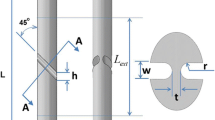Abstract
Methods of investigating the plastic flow of materials at high rates are reviewed, and experiments are described in which thin-walled tubular specimens were subjected to dynamic torsional loading. These experiments were performed using a modified version of a torsional Hopkinsonbar apparatus used in earlier work. The results show that, at strain rates of order 103 sec−1, the stress-strain curve of the alloy tested does not differ significantly from that found at 10−3 sec−1. In tests involving the propagation of a stress increment, however, it was found that the speed of propagation was that of elastic shear waves, indicating that the initial response of the material is essentially rate dependent.
Similar content being viewed by others
References
Yew, C. H. andRichardson, H. A., Jr., “The Strain-rate Effect and the Incremental Plastic Wave in Copper,”experimental Mechanics,9 (8),366–373 (1969).
Campbell, J. D. andDowling, A. R., “The Behaviour of Materials Subjected to Dynamic Incremental Shear Loading,”Jnl. Mech. Phys. Solids,18,43–63 (1970).
Frantz, R. A., Jr. and Duffy, J., “The Dynamic Stress-Strain Behaviour in Torsion of 1100-0 Aluminum Subjected to a Sharp Increase in Strain Rate,” Brown University Report DAHC04 70 C 0035/1 (1971).
Klepaczko, J., “Effects of Strain-Rate History on the Strain Hardening Curve of Aluminium,”Arch. Mech. Stos.,2,19,211–229 (1967).
Ripperger, E. A. andWatson, H., “The Relationship Between the Constitutive Equation and One-Dimensional Wave Propagation,”in Mechanical Behaviour of Materials under Dynamic Loads, U. S. Lindholm, ed., New York, Springer-Verlag (1968).
Malvern, L. E., “The Propagation of Longitudinal Waves of Plastic Deformation in a Bar of Material Exhibiting a Strain-Rate Effect,”Jnl. Appl. Mech.,18,203–208 (1951).
Kolsky, Y. andDouch, L. S., “Experimental Studies in Plastic Wave Propagation,”Jnl. Mech. Phys. Solids,10,195–223 (1962).
Bell, J. F., “Propagation of Plastic Wavesin Prestressed Bars,”Tech. Report No. 5, HG-ONR-243, VIII, The John Hopkins University, Baltimore, Md. (1951).
Sternglass, E. J. andStuart, D. A., “An Experimental Study of the Propagation of Transient Longitudinal Deformations in Elastoplastic Media,”Jnl. Appl. Mech.,20,427–434 (1953).
Alter, B. E. K. andCurtis, C. W., “Effect of Strain-Rate on the Propagation of a Plastic Pulse Along a Lead Bar,”Jnl. Appl. Phys.,27,1079–1085 (1956).
Bianchi, G., “Some Experimental and Theoretical Studies on the Propagation of Longitudinal Plastic Waves in a Strain-Rate Dependent Material,”in Stress Waves in Anelastic Solids, H. Kolsky andW. Prager, eds., Berlin, Springer-Verlag (1964).
Convery, E. andPugh, H. Ll. D., “Velocity of Torsional Waves in Metals Stressed Statically into the Plastic Range,”Jnl. Mech. Eng. Sci.,10,153–164 (1968).
Maiden, C. J. andGreen, S. J., “Compressive Strain-Rate Tests on Six Selected Materials at Strain Rates from 10 −3 to 10 4 in/in/sec,”Jnl. Appl. Mech.,33,496–504 (1966).
Holt, D. L. et al., “Strain-Rate Dependence of Flow Stress in Some Aluminum Alloys,”Trans. A.S.M.,60,152–159 (1967).
Lindholm, U. S., “Some Experiments with the Split-Hopkinson Pressure Bar,”Jnl. Mech. Phys. Solids,12,317–335 (1964).
Steidel, R. F. and Makerov, C. E., “The Tensile Properties of Some Engineering Materials at Moderate Rates of Strain,” ASTM Bulletin, 57–64 (July 1960).
Taylor, D. B. C. andMalvern, L. E., “Dynamic Stress and Deformation in a Mild Steel at Normal and Low Temperatures,”in Response of Metals to High Velocity Deformation, P. G. Shewmon andV. F. Zackay, eds., New York, Interscience (1961).
Camphell, J. D. and Lewis, J. L., “The Development and Use of a Torsional Split Hopkinson Bar for Testing Materials at Shear Strain Rates up to 15000 sec −1 ,” Report No. 1080, 69, University of Oxford, Department of Engineering Science (July 1969). [See, also, paper to be published in Experimental Mechanics,12,(11), 520–524 (1972).]
Author information
Authors and Affiliations
Rights and permissions
About this article
Cite this article
Nicholas, T., Campbell, J.D. Shear-strain-rate effects in a high-strength aluminum alloy. Experimental Mechanics 12, 441–447 (1972). https://doi.org/10.1007/BF02328813
Received:
Revised:
Issue Date:
DOI: https://doi.org/10.1007/BF02328813




